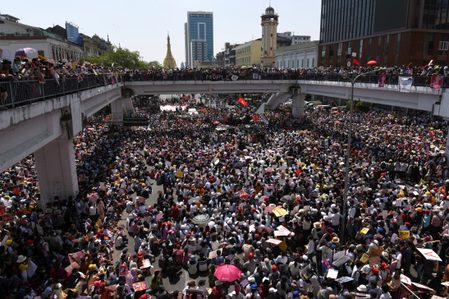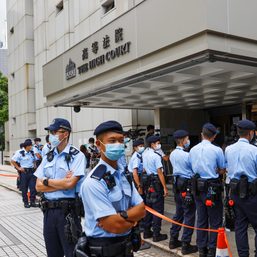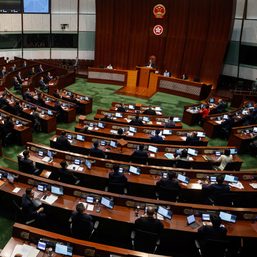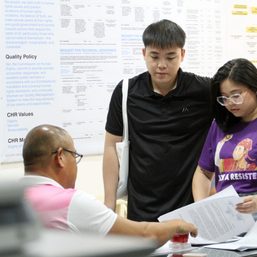SUMMARY
This is AI generated summarization, which may have errors. For context, always refer to the full article.
![[OPINION] Release Saw Lin Htet](https://www.rappler.com/tachyon/2021/04/ispeak-tatmadaw-sq.jpg)
On April 8, when Twitter launched the Milk Tea Alliance emoji, it hinted at the significance of the growing student participation in Asia’s pro-democratic political movements. Over the past year, various demonstrations against creeping authoritarianism across the region have shown how young people have emerged as an important force in protecting their fragile democracies. These protests have also debunked the myth that young people are oblivious to political developments in their countries. Meanwhile, through their brutal use of force against the students, the governments, too, have tacitly confirmed this fact. One example of this comes from the ongoing civilian protest against the Tatmadaw, Myanmar’s military, by the country’s youth.
Students have been at the forefront of the recent protests in Myanmar. When the civil disobedience movement began, soon after the February 1 coup, thousands of students went to the streets. However, the crackdown on these protests has been severe. Hundreds of students have been arrested and several killed. In fact, the first reported death following the protests was that of a 19-year-old who succumbed to the injuries obtained after being shot by the military. As of March 9, almost 3,000 protesters have been arrested, and the military has slaughtered more than 600.
The protests, which include a diverse coalition of groups, appears to be largely decentralized in nature. The army has also disrupted the internet connections throughout the country to prevent demonstrators from coordinating their activism.
However, this is not the first time in Myanmar’s history that students have spearheaded the fight for democracy. The “8888 uprisings” began as protests by students in Yangon in 1988. The Tatmadaw retaliated with a deadly show of violence, arresting, wounding, and even killing thousands. Most of these victims were student protesters. Similarly, in 1991, when Aung Sung Suu Kyi was put under house arrest by the military junta, student protests erupted all over the country demanding her release. The universities were then also among the first places to be shut down by the military. The repeated attacks on students, academics, and institutions promoting democratic values are a clear sign that the Army fears spaces that enable open exchange and dissent, and feels powerful by suppressing them.
One such victim of the military’s wrath is 37-year-old Saw Lin Htet, a human rights student, who was our fellow classmate at the Institute of Human Rights and Peace Studies, Mahidol University, Thailand. When the military coup threw his country into chaos, Saw Lin had been back in the country only a few months. On March 23, as he was traveling with his four-year-old daughter, he was stopped at a checkpoint by the military, who then searched his car. They proceeded to arbitrarily arrest Saw Lin and took him to the Taung Kalay prison in Kayin State. He was to be presented to the court on April 6, but this was later canceled. Sources from Myanmar indicate that, on the same day, he was taken away by intelligence officers of the Army.
For 15 days Saw Lin’s wife and lawyer did not know his whereabouts; he was a subject of enforced disappearance. This was a worrying development since the Myanmar military is known to torture and extrajudicially execute those who have been forcibly disappeared.
On the evening of April 20, Saw Lin was said to be brought back to a prison in Karen State. Although he is expected to face trial on April 21, prospects of his release remain unclear.
Saw Lin’s forceful disappearance and arbitrary arrest by the Tatmadaw shows that student participation is perceived as a threat by the current regime. Like Saw Lin, hundreds of students who are participating in the protest are putting their lives at risk every day. The military junta is attempting to suppress these brave voices through propaganda and arrest. This is, however, being thwarted by the resilience evident in the fearless protesters. With their undying hope, they are moving forward to dismantle the decades-old hold of the military regime in Myanmar’s politics.
The Tatmadaw has crushed the futures and hopes of many generations before this and is adamant on doing the same now to hold on to economic and political power. To the Myanmar Army, this might seem like a repeat performance of their previous oppressions. However, 10 years of democracy has transformed Burmese society, and today’s generation knows what an open society feels like. In many ways, this explains the organic nature of many forms of resistance that Myanmar currently witnesses. And this commitment shown by Saw Lin Htet and thousands like him might very well determine Myanmar’s democratic future. – Rappler.com
Shraddha Pokharel and Ojaswi KC are human rights researchers, and are part of the Global Campus Coalition for Human Rights.
Add a comment
How does this make you feel?
![[ANALYSIS] Will the Philippines go the way of Myanmar and Cambodia?](https://www.rappler.com/tachyon/2021/04/myanmar-tragedy2.jpg?fit=449%2C449)











There are no comments yet. Add your comment to start the conversation.